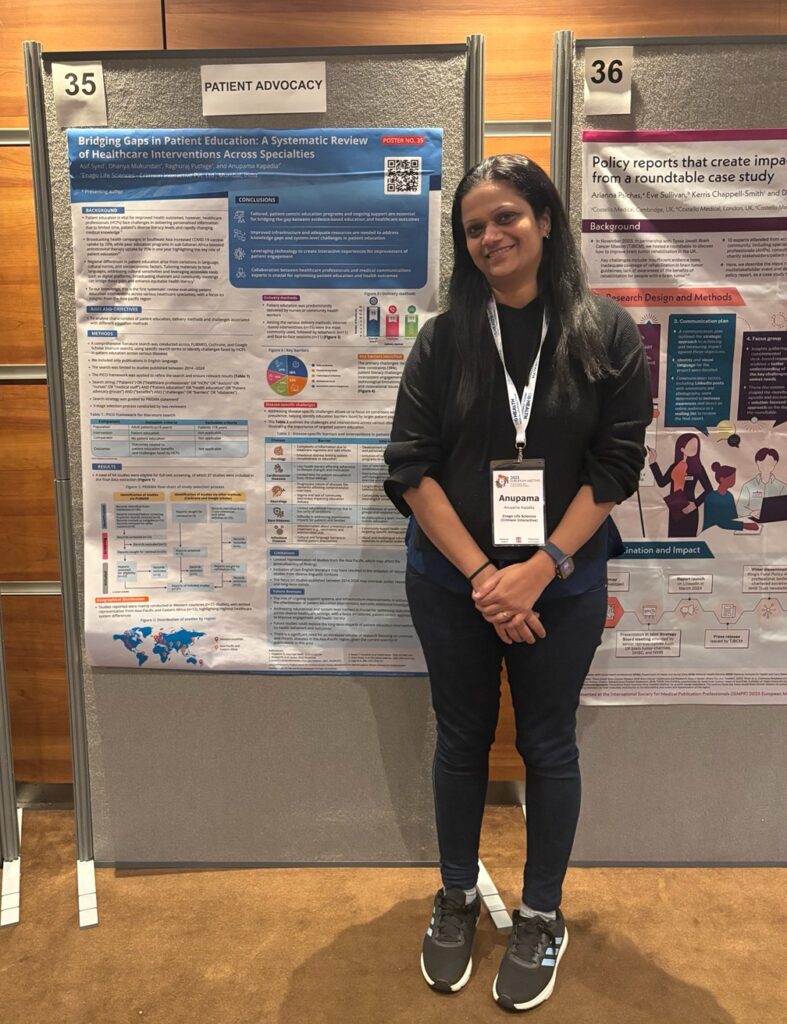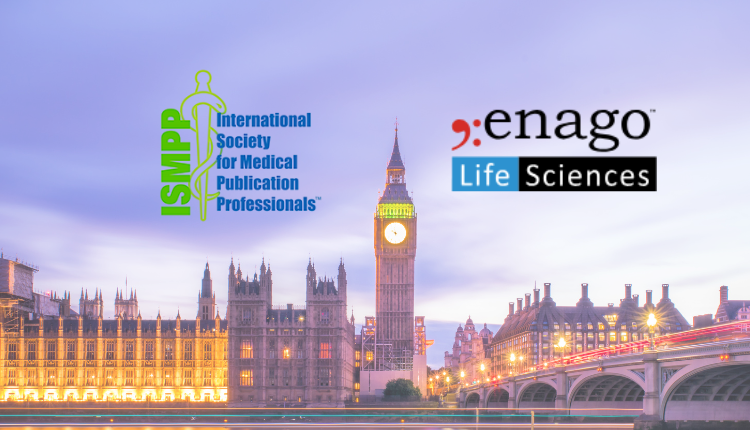Attending the 2025 European Meeting of the International Society for Medical Publication Professionals (ISMPP EU) in London from January 27-29 was an experience filled with insightful discussions, networking, and a forward-thinking approach to medical publications. This year’s theme, “Core Values for an Integrated Age,” reflected the evolving landscape of medical communication—one that balances speed, quality, ethics, patient involvement, and technological advancements.
Here’s my detailed take on this incredible conference, covering key takeaways, standout sessions, and the vibrant discussions that shaped my experience.
Day 1: Setting the Stage for Integration and Inclusion
After an evening of attending workshops, networking, and setting up our poster on January 27, I arrived at the event location early on January 28, excited to dive into the program.
Mithi Ahmed-Richards (Taylor & Francis) kicked things off with a warm welcome, emphasizing ISMPP’s commitment to global collaboration. A highlight of the opening remarks was Ann Gordon (Chair, ISMPP Certification Board) announcing the growth of the Certified Medical Publication Professional (CMPP™) credential, which now boasts 1,659 certified professionals across 31 countries. This expansion underscores the growing demand for publication professionals with formalized expertise in the field.
Keynote Address: Learning from a Nomadic Life
The keynote session by Andy Pag, an environmental journalist and adventurer, was truly engaging. He shared his experience traveling the world on alternative fuels, including a car running on chocolate waste biofuel! His main message—sustainability requires incremental progress, not just grand gestures—resonated deeply. It made me think about how this applies to medical publications: innovation and ethics must evolve hand-in-hand, with thoughtful, sustainable progress.
The Role of Patients in Medical Communications
One of the most powerful sessions of the day was the plenary on patient involvement in medical publications and scientific conferences. Mercy Shibemba, a patient advocate, passionately discussed why “Nothing for us without us” should be the guiding principle of patient engagement. Her key point? Tokenistic inclusion isn’t enough—patients need to be actively involved in research, authorship, and discussions.
A particularly revealing part of this session was the misconception that regulations prevent patient involvement. Rina Newton (compliance expert) clarified that industry codes don’t actually prohibit patient engagement in publications; rather, the barriers are often due to internal company policies and risk-averse mindsets.
This was a major wake-up call for many of us in the audience. How often do we assume things are “not allowed” without checking the actual regulations? This session pushed me to rethink how I advocate for patient involvement in my own projects.
Day 2: Balancing Speed, Quality, and Technology in Publications
Day 2 was jam-packed with discussions on the evolving role of AI, fast-tracked publications, and the challenges of maintaining publication integrity in a high-speed environment.
The Speed vs. Quality Dilemma in Publications
One of the most debated topics was whether medical publications should be accelerated—and if so, how to do it without compromising quality. The panel, which included medical journal editors, pharmaceutical publication leads, and medical writers, examined case studies of accelerated manuscripts.
Key takeaways:
- Rapid publications should be the exception, not the norm.
- Pre-planning is crucial—rushed publications are often a result of poor upfront strategy, not just tight deadlines.
- Technology (AI, automation) can help, but human oversight remains essential.
As someone who has worked on accelerated manuscripts before, this session was a valuable reminder that speed should never come at the cost of transparency, accuracy, or ethical considerations.
AI in Medical Publications: Hype or Real Impact?
Another highlight of the day was the AI-focused sessions. AI has been the buzzword in every industry, and medical communications are no exception. But how much of AI’s potential is real, and how much is hype?
Panelists shared real-world applications of AI in:
- Systematic literature reviews (faster identification of relevant studies)
- Plain language summaries (automating first drafts)
- Data visualization and summarization
While AI can enhance efficiency, discussions also touched on key risks:
- Hallucinations (AI generating incorrect or misleading information)
- Data privacy and security concerns
- Regulatory uncertainty
The general consensus? AI is a valuable tool—but it’s not replacing human expertise anytime soon.
This session left me eager to explore how I can responsibly integrate AI into my workflows, especially for time-consuming tasks like literature reviews.
Networking, Posters, and Industry Conversations
Beyond the formal sessions, the poster presentations and networking sessions were fantastic. It was fascinating to see the range of research showcased—from real-world evidence studies to best practices in open-access publishing.
I had some great discussions with fellow attendees about:
- The evolving role of medical writers in an AI-driven world
- Best practices for improving journal submission success rates
- How to advocate for more inclusive authorship policies
I also attended a roundtable discussion on preprints in pharma publications—a hot topic as the industry grapples with the balance between early data dissemination and the need for peer review.
Final Thoughts: Key Takeaways and Future Directions
ISMPP EU 2025 was an incredibly valuable experience. The key themes that stuck with me are:
- Patient involvement must be meaningful, not just symbolic. We need to challenge assumptions about regulatory restrictions and actively bring patients into the process.
- Speed vs. quality is a real challenge. Accelerated publications can be done, but they require strategy, planning, and ethical oversight.
- AI is a powerful tool—but it’s not a silver bullet. We should embrace automation for efficiency, but critical thinking and human expertise remain irreplaceable.
- Collaboration is key. Whether it’s publishers, pharma, patients, or technology experts, working together will define the future of medical communications.
Our Poster Presentation: Addressing Challenges in Patient Education

One of the most rewarding moments of ISMPP EU 2025 was presenting our poster, co-authored by Asif Syed, Dr. Dhanya M, and Dr. Raghuraj P.
Our systematic review focused on:
- Critical challenges in patient education across various healthcare specialties
- Impact of known and innovative solutions for overcoming these barriers
We examined barriers such as low health literacy, language constraints, lack of accessible materials, and limited patient engagement in treatment decisions. At the same time, we highlighted innovative strategies—including AI-powered patient education tools, interactive digital platforms, and tailored communication approaches—that are improving patient understanding and involvement.
Presenting our findings to an international audience was a fantastic opportunity. It sparked meaningful discussions with professionals from different backgrounds, offering fresh perspectives on how we can refine our work further. We also gathered valuable feedback, especially on ways to enhance patient education through more collaborative, real-world initiatives.
The enthusiasm and engagement from attendees reinforced how patient education remains a crucial, yet often overlooked, aspect of healthcare communication.
For those who missed the event and want to know more about the changing environment in publications, feel free to message me on LinkedIn and I will be happy to chat!
Would I attend again? Absolutely. The conversations, insights, and connections made this one of the most valuable conferences I’ve attended. I left feeling inspired, informed, and ready to apply these learnings to my work in medical publications.
See you at ISMPP EU 2026!
Author:
 Dr. Anupama Kapadia
Dr. Anupama Kapadia
General Manager, Enago Life Sciences
Connect with Anupama on LinkedIn

